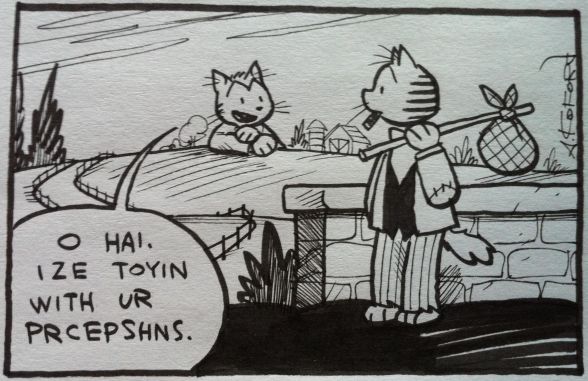The toothbrush fence (as mentioned in Flight of the Conchords).
Site design
We’re getting mixed reviews on the latest site design. I’m not especially fond of the current theme (I’m especially irritated that by default it hijacks the favicon—I suspect the previous theme also was trying to that but had some problem that prevented it from succeeding), but have not yet found one that lets me have an arbitrary header image with a completely pleasing layout. More changes will doubtless be implemented; I really don’t want to build my own theme, but will if pressed.
Anyway, thanks for the feedback (it’s always nice to know people are reading).
Edited to add that I’m hating the newest theme less than the previous one.
Children’s Hour Review
The Children’s Hour. Good. I knew the general outline of the story from having paid attention to life (and in particular to The Celluloid Closet), but had never seen the film. Aside from a couple minor surprises, it was just as expected. The direction was lovely, with a couple particularly striking sequences, and the acting of the two leads was a delight. The children were less compelling (especially the spoiled brat Mary), and James Garner was serviceable until called upon to express an emotion other than annoyance. He really is much better suited to Messrs. Maverick and Rockford.
January Reading
Big Fan Review
Big Fan. Okay. I think this film was done a disservice by its trailer, though I completely believe it would be challenging to create a perfect trailer for it. Patton Oswalt is great, as expected. This is the second film I’ve watched recently, though, in which I found the pacing, shall we say, contemplative. Maybe this effect was accentuated by my watching it on my laptop; regardless, I don’t think that I’ve just been so trained by modern media to expect something to happen every three seconds that anything slower makes me antsy.
Related (but not identical) to my issues with pacing, I wonder if maybe the film would have made me happier at about half its length. You’ll never get a theater distribution deal for a 45-minute film, but there are enough alternative distribution outlets out there now that it ought to be possible to get such a work in front of at least as many eyes as would see it in “selected cities.”
Collected Zelazny Vol. 6 Review
The Road to Amber: Volume 6: The Collected Stories of Roger Zelazny, ed. Grubbs, Kovacs, Crimmins. Yes. I was a little surprised to find I hadn’t read all of Zelazny’s contributions to George R.R. Martin’s Wild Cards series, and so was pleased to have the opportunity to rectify that situation. I was disappointed to see some reports that Robert Sheckley was not the most honorable of collaborators: re-writing Zelazny’s work after being asked not to, claiming to have written the first of their novels with almost no Zelazny input, and other contrary-to-documented-events assertions. Doubtless every human endeavor is freighted with, well, humanity.
A treat in this volume is an essay by Michael Whelan providing insight into his lovely cover art for the series. When he says “…once I had the essential foreground/background areas defined I went to work, trusting myself to find the shapes in the image as I worked on it”, I hear echoes of one of Zelazny’s most frequent approaches to composition.
Many thanks to the New England Science Fiction Association, and especially editors David G. Grubbs, Christopher S. Kovacs, and Ann Crimmins, for tackling this project and seeing it through.
Collected Zelazny Vol. 5 Review
Nine Black Doves: Volume 5: The Collected Stories of Roger Zelazny, ed. Grubbs, Kovacs, Crimmins. Yes. Another collection that does what it says on the tin, this one includes the last of the Dilvish shorts and other later work. I found myself increasingly fond of the story “Permafrost”, contained in this collection, due in no small part to passages such as this one: “The wind, already heavy, rises, hurling particles of ice against the building with a sound like a multitude of tiny claws scratching.”
I had not at all remembered reading “The Bands of Titan”, so was surprised to see that it had been collected in Frost & Fire. On the other hand, I found it fairly forgettable on this reading, too.
Friends of the Collective will likely recognize one of the names listed amongst the proof-reading corps in the backs of Volumes 5 and 6.
December Reading
Which means there were 7-9 more before!
Great: Found a CD at the library called Now That’s What I Call Arabia 10 (with cover and font in the style of those Now That’s What I Call Music CDs). Even Better: The computer recognized it as The Best Arabian Album 8!
First I was all “That’s a thing?”, then I was all “That’s great!”
Adoration of Jenna Fox Review
The Adoration of Jenna Fox, Pearson. Yes. I’m not sure I would recommend this book to anyone: it bears the earmarks of sf written by a non-sf writer in that some obvious questions are implied but not explicitly raised (and certainly not addressed); I found the scientific rationale to be very hand-wavy, yet at more length than hand-waving can really support (repeating the same hand-waving several times doesn’t make it any more credible); and it more reminded me of books I would recommend than it was one.
Pearson’s writing was reasonably solid (the appearance of the alternative spelling “imposter” for “impostor” distracted, but it is a time-honored variant); in particular, characterization of individuals (if not society) was believable, with one glaring exception (my librarian tells me that the omission was most likely in order to meet grade-level criteria). Nevertheless, I can recommend several other explorations of the same themes over this one, most of them non-fiction.
